Heating systems in motorhomes: heater options for a comfortable temperature in the camper
Have you started thinking seriously about caravanning and want to make long trips in comfortable conditions? Then you need, first of all, to worry about the warmth and comfort of the camper. To do this correctly, you need to find out what heating systems exist in motorhomes and understand their advantages and disadvantages.
We will tell you not only about heating systems, but also pay attention to the operating efficiency of each of them. After studying the material, you can easily choose the ideal option for heating the camper, taking into account the simplicity of the device, ease of use, autonomy and safety of the system.
The content of the article:
Motorhome heating systems
All camper heating systems can be divided according to two main criteria - the method of heating the coolant, the fuel source. The most widespread are air-cooled heaters.
The essence of their work is to take in cold air, heat it and then supply it to the residential module. The high speed of heating the room and the low cost of the equipment are the main indicators that explain the popularity of such heaters.
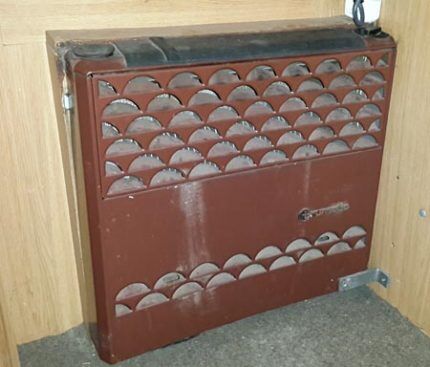
The disadvantages include high fuel consumption and uneven distribution of warm air. A system with a liquid coolant looks more complex, but also more advanced.
Its operation is based on heating the water circulating in the system, which enters the radiators responsible for heat distribution.

When installing such a system, you can consider the option of a heater with a built-in heat exchanger, which, in addition to heating, will also provide hot water to the residents of the motorhome.
Camper Heating Options
The following sources of thermal energy can be used to heat motorhomes:
- Electricity;
- Solid fuel (firewood, pellets, pressed sawdust, coal);
- Liquid fuel (gasoline, diesel fuel);
- Gas.
Let's briefly consider each of the sources of thermal energy and try to choose the most optimal option for heating the camper.
Camper heating with electricity
Electric camper heating is not even considered as the main source of heating. Electric radiators and underfloor heating systems require connection to a 220 V network and a current power of at least 10 A. This is only possible in equipped parking lots.
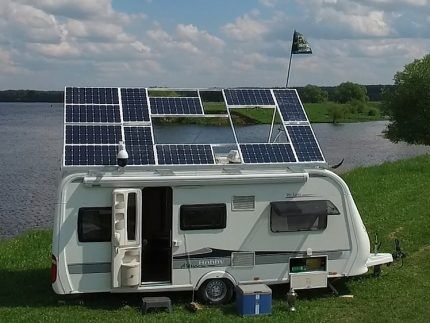
Electric heating is out of the question on the road, but at equipped campsites electric convector heaters may be useful for maintaining a supply of the main heating source.
Solid fuel for the stove
Basically, firewood is used as solid fuel. The heater is not a full-fledged fuel boiler, but an ordinary potbelly stove.
This heating system is only effective for short trips of 2-3 days.
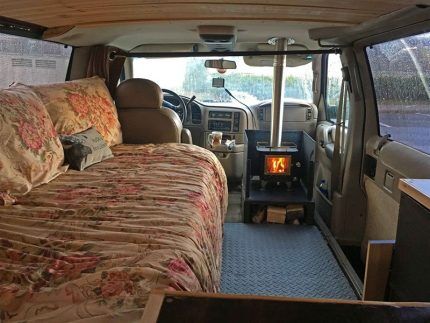
For a long trip you will need a lot of firewood, their placement will reduce the spacious area of the module. And the autonomy of such heating is out of the question, since the firewood burns out very quickly and you constantly need to be distracted by servicing the stove.
An alternative to firewood can be pellets or pressed sawdust, called Eurowood. Although they are consumed much more slowly, they will still require a large area to accommodate their supply.
Liquid fuel heaters - gasoline, diesel fuel
Gasoline or diesel fuel can be used as liquid fuel. They are taken directly from the tank. The advantage of such a system is its location.
It is located under the floor of the camper, which allows rational use of the space of the motorhome. During the cold season, such a system can be used to warm up the engine before starting.
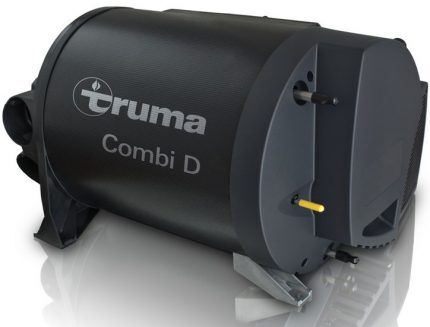
The disadvantage of liquid fuel heaters is the high noise level during their operation. Even with perfect sealing of the windows and door of the camper, it will not be possible to completely avoid the smell of gasoline or diesel fuel in the room.
In addition, you will have to constantly monitor the fuel level in the tank, since in the cold season its consumption increases significantly. Stopping with an empty tank several tens of kilometers before a gas station is not the best travel option.
Gas-fired camper heaters
The main advantage of gas heaters is their higher efficiency compared to electricity, liquid and solid fuel. In addition, such heaters are characterized by their autonomy.
Modern automation of gas equipment allows you not only to select the operating mode, but also to fully automate the operation of the heating system.

Compact gas cylinders standard sizes can provide camper residents with heat and a sufficient supply of hot water for a week, even in the cold season. If necessary, standard cylinders can be replaced with cylinders of larger capacity, thereby increasing the fuel supply by 8-10 times.
Thanks to its autonomy, comfortable operation and high efficiency, it is gas heaters for garages and campers are the most popular among most caravanning fans.
Therefore, we will dwell on gas camper heating in more detail, consider the principle of operation of the equipment, installation features, as well as safety measures during their operation.
Gas heating for motorhomes
The gas heating system of a motorhome using a liquid coolant is practically no different from the autonomous heating of a private house or apartment using a stationary gas boiler. In the same way, water is heated in a heat exchanger and then distributed through pipes to heating radiators.
A heater operating on the principle of a traditional gas convector can also be used for heating. The air needed to burn the gas does not come from the camper, but is taken from outside.
Thus, the inhabitants of the motorhome do not experience oxygen deficiency. The additional installation of a fan helps to evenly distribute warm air to the most distant parts of the room.
Correct placement of cylinders
For gas cylinders in a motorhome, there is usually a compartment on the outside of the side. If we are talking about a caravan, then the cylinders are located above the towbar in the luggage compartment area. The cylinder is connected to the system using a flexible hose with subsequent distribution through a pipeline directly to the source of consumption.
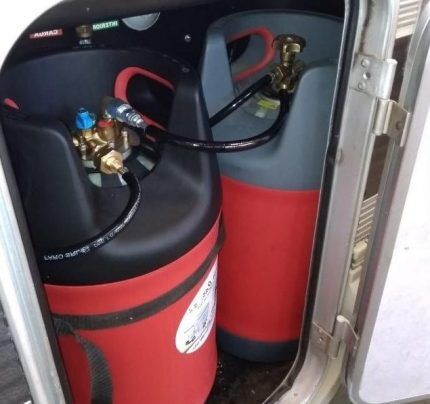
Traditional compartments hold two gas cylinders. This is a very important point, since without special sensors it is difficult to determine the remaining fuel in the cylinder. It is advisable to always have one full cylinder in reserve so as not to be left without gas on the road.
Golden Rule refill an empty cylinder will avoid inconvenience as soon as possible.A standard cylinder holds 11 kg of gas; if necessary and there is space, you can easily install a 100 liter cylinder and travel the longest distances without regard to the need to refuel.
Removal of combustion products
As a result of the use of gas, combustion products are formed that require removal. The combustion product exhaust system is a conventional steel or coaxial pipe. Depending on the model, the exhaust pipe is mounted in the side wall of the motorhome or in the roof.
In heaters with liquid coolant from the manufacturers Alde and Primus, combustion products are removed through the side wall. At the same time, in traditionally used Trumo air gas heaters, combustion products are discharged through a pipe that is mounted in the roof of the camper.
The best manufacturers of gas heating systems
Our climate is very similar to the harsh Scandinavian climate, where caravanning is very popular.
Therefore, it doesn’t hurt to look at our Scandinavian neighbors to pay attention to the manufacturers of gas heaters for campervans, which have proven themselves when operating in critically low temperatures without compromising the living comfort of travelers.
Alde and Primus with liquid coolant
The basis for the operation of heating systems of Alde and Primus companies is a liquid coolant (antifreeze). The system itself is an exact copy of the traditional heating system used in autonomous heating. Heating radiators are located around the perimeter of the motorhome and are connected to each other by an aluminum pipe.
The boiler is equipped with a low speed circulation pump, which pumps coolant along the circuit.A 12 V battery is sufficient for its operation. The gas boiler operates autonomously, but has a built-in module that can be connected to a 220 V power supply at the campsite.
The air heated by the radiators rushes along the windows to the upper part of the cabin, through the ventilation holes it enters under the roof, where it cools and rushes to the central part of the camper.
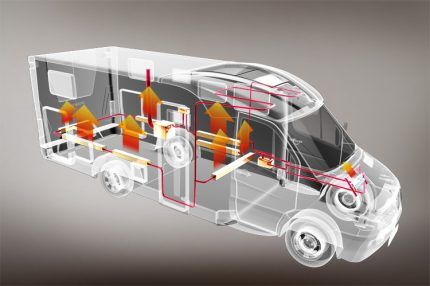
Often, boilers are equipped with a system of underfloor heating with liquid coolant, which moves along a coil mounted in a sandwich panel. The additional circuit may be closed when installing valves.
Truma with air coolant
The operating principle of the Truma closed-type gas burner is to take cold air from the camper, then heat it and return it to the residential module. An air duct system is used to distribute warm air evenly.
The uniformity of air supply is enhanced by a small fan. The distribution of warm air can be adjusted by dampers installed on each air duct.
The peculiarity of the Truma gas burner is its ignition using a piezoelectric element. Starting is not carried out using a battery, but AA batteries are used. The interior of the camper warms up much faster than with heating systems with liquid coolant, but at the same time gas consumption increases, and the warm air is not distributed as evenly.
Gas heaters for heating a camper are distinguished by their autonomy, and when using high-quality automation and installation standards, they are characterized by safe operation.
When choosing the power of the equipment, you need to focus on the area of the motorhome and climatic conditions. For long trips, a liquid system is ideal. coolant, and for short forays into nature, an air one is enough.
Conclusions and useful video on the topic
Installing a gas convector in a motorhome:
Review of the Truma 3000 gas heater:
Features of refilling gas cylinders of various standards and solving problems with their refilling:
Automobile caravanning is exciting, but at the same time it is very serious. When choosing a gas heater, preference should be given to brands whose product quality has been tested by time.
This way you will not only ensure a high level of comfort during your trip, but also receive a guarantee for the operation of the purchased equipment.
Would you like to share your RV heating options? Do you have useful information on the topic of the article that is worth sharing with readers? Please leave comments in the box form below, ask questions about interesting or controversial issues, and post photos.




Wouldn't a hair dryer like Webasto or Eberspächer be enough to heat the interior? In general, it’s a discovery for me that in our country there are caravanning enthusiasts.
Where can I buy a gas camper heater?